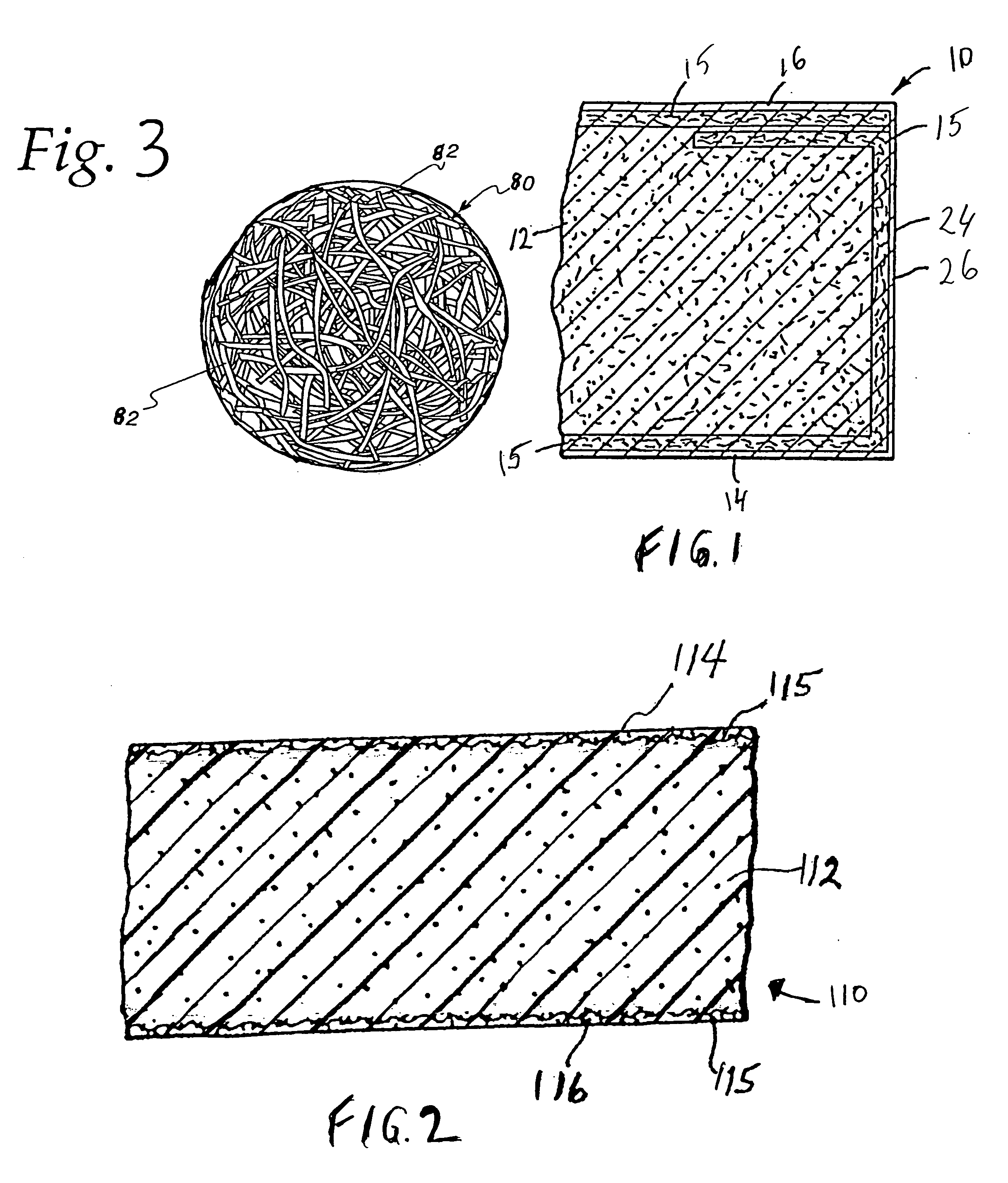Anti-microbial and anti-fungal additives to provide mold and mildew resistance
Inactive Publication Date: 2007-03-01
BPB PLC
View PDF33 Cites 9 Cited by
- Summary
- Abstract
- Description
- Claims
- Application Information
AI Technical Summary
Benefits of technology
[0010] Accordingly, what is described and claimed herein is a group of naturally and organically derived compounds extracted from oils of known plant species, which in small amounts can be effective to significantly inhibit the growth of several and a broad range of species of mold and mildew that are commonly known to grow in fibrous generally, or in building materials during and after construction. In a preferred embodiment, the compounds effective to provide anti-bacterial, anti-viral and anti-fungal characteristics are derived from oils or concentrates from several plant species taken from the families of Myrtacea, Rutacea, Zingiberaceae and Labiatea. It has been found that the essential oils derived from the genus Melaleuca, and especially Melaleuca quinquenervia, possess potent mold and mildew growth inhibitors and specifically the compounds derived therefrom that include several terpenes and linalol, as described in greater detail below.
[0011] It has further been found that use of the inventive anti-bacterial, anti-viral and anti-fungal compounds and compound combinations found in the oils can be most
Problems solved by technology
Recent trends in building materials tend toward the use of inorganic component materials, at least partially to upset any fertile base that may provide for growth of mold and mildew.
However, all these prior art methods and systems rely on expensive, and possibly environmentally detrimental, synthetic anti-bacterial or anti-fungal compounds, some of which have been used as insecticides or pesticides.
Synthetic pesticide compounds, as have been taught in the prior art, potentially can pose health risks associated with their use, especially for those individuals who may be susceptible to even minute concentrations, in whom such minute concentrations may trigger physiological responses.
Additionally, with modern insulation methods that result in tighter sealing of newer construction, even minute levels of any chemical permeating an indoor environment may become more concentrated through time as the indoor environment recirculates the air.
Method used
the structure of the environmentally friendly knitted fabric provided by the present invention; figure 2 Flow chart of the yarn wrapping machine for environmentally friendly knitted fabrics and storage devices; image 3 Is the parameter map of the yarn covering machine
View moreImage
Smart Image Click on the blue labels to locate them in the text.
Smart ImageViewing Examples
Examples
Experimental program
Comparison scheme
Effect test
example 1
Clove Oil (Syzygium aromaticum) at Different Concentrations
[0032]
Sample 1A (0.055%)Sample 1B (0.11%)WeekFrontBackFrontBack11010109299973887546653
example 2
Palmarosa Oil (Cymbopogon martiniii)
[0033]
Sample 2A (0.055%)Sample 2B (0.11%)WeekFrontBackFrontBack199910278783565644445
example 3
Cinnamon Bark (Cinnamonum verum)
[0034]
Sample 3A (0.055%)Sample 3B (0.11%)WeekFrontBackFrontBack18899267883567844567
the structure of the environmentally friendly knitted fabric provided by the present invention; figure 2 Flow chart of the yarn wrapping machine for environmentally friendly knitted fabrics and storage devices; image 3 Is the parameter map of the yarn covering machine
Login to View More PUM
 Login to View More
Login to View More Abstract
A naturally derived additive to fibrous materials and to building materials for imparting resistance to mold and mildew growth, including one or more additives extracted from a group of plant species, such as those from the families of Myrtacea, Rutaceaea, Zingiberaceae and Labiatae and essential oils derived from specific species such those selected from the following groups: Melaleuca quinquenervia, Melaleuca ericifolia, Melaleuca altemifolia, Melaleuca leucadendron, Citrus reticulata and Origanum vulgare.
Description
BACKGROUND OF THE INVENTION [0001] 1. Field of the Invention [0002] This invention relates generally to building materials, and more specifically to additives that can be incorporated with building materials so as to provide mold and mildew resistance thereto. [0003] 2. Background Art [0004] Recent trends in building materials tend toward the use of inorganic component materials, at least partially to upset any fertile base that may provide for growth of mold and mildew. For example, commonly assigned U.S. Pat. No. 6,524,679 utilizes a material comprising randomly oriented inorganic fibers as an underlying facing material to avoid absorption and wicking of water or other liquids that may come into contact with the gypsum plasterboard made in accordance with the methods taught therein. This patent and the following commonly assigned patents and applications are incorporated herein by reference: patent application Ser. No. 10 / 968,680 filed on Oct. 19, 2004 and published under Publicat...
Claims
the structure of the environmentally friendly knitted fabric provided by the present invention; figure 2 Flow chart of the yarn wrapping machine for environmentally friendly knitted fabrics and storage devices; image 3 Is the parameter map of the yarn covering machine
Login to View More Application Information
Patent Timeline
 Login to View More
Login to View More IPC IPC(8): A01N25/00A01N65/00
CPCA01N65/00A01N25/34A01N65/08A01N65/22A01N65/24A01N65/28A01N65/36A01N65/44A01N65/48
Inventor HAUBER, ROBERT J.HENNIS, MARK E.
Owner BPB PLC
Features
- R&D
- Intellectual Property
- Life Sciences
- Materials
- Tech Scout
Why Patsnap Eureka
- Unparalleled Data Quality
- Higher Quality Content
- 60% Fewer Hallucinations
Social media
Patsnap Eureka Blog
Learn More Browse by: Latest US Patents, China's latest patents, Technical Efficacy Thesaurus, Application Domain, Technology Topic, Popular Technical Reports.
© 2025 PatSnap. All rights reserved.Legal|Privacy policy|Modern Slavery Act Transparency Statement|Sitemap|About US| Contact US: help@patsnap.com

